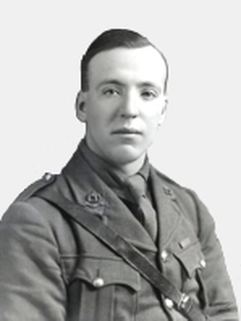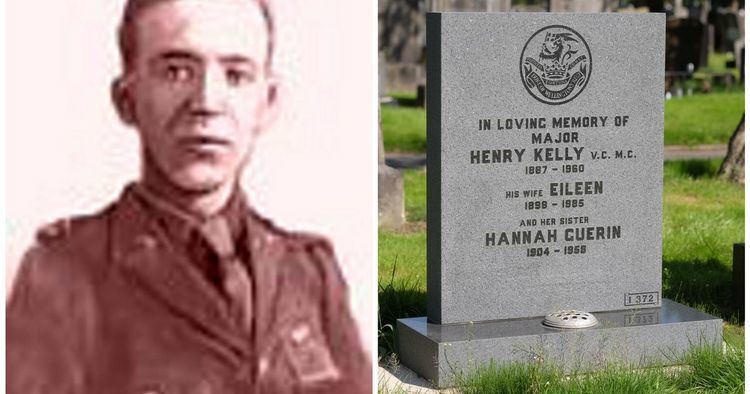Rank Major | Name Henry Kelly Role Armed force officer | |
 | ||
Battles/wars World War IIrish Civil WarSpanish Civil WarWorld War II Similar People George Grogan, Robert Henry Cain, Raphael Zengel, Walter Norris Congreve, James Carne | ||
Years of service 1914–1920, 1939–1944 | ||
Major Henry Kelly VC, MC & Bar (10 July 1887 – 18 July 1960) was an English recipient of the Victoria Cross, the highest and most prestigious award for gallantry in the face of the enemy that can be awarded to British and Commonwealth forces.
Contents
- Early life
- Award of Victoria Cross
- Award of Military Cross
- Award of Bar to Military Cross
- Between the wars
- Post war
- Medal location
- References

Kelly was born on 10 July 1887 in Collyhurst, Manchester. He was a temporary second lieutenant in the 10th Battalion, The Duke of Wellington's (West Riding) Regiment during the First World War at the time of his award of the Victoria Cross in 1916. He was awarded a Military Cross and later a Bar to that medal in Italy in 1918. Other Military awards include the Belgian Croix de guerre, the French Médaille militaire and the Spanish Grand Laurelled Cross of San Fernando.

Early life
Henry Kelly was born to Charles Kelly of Dublin and Jane (née McGarry) of Manchester. He was left the oldest of 10 children after his father died in 1904. He was educated at St Patrick's School and Xaverian College, both in Manchester. After moving to King Street in Moston he was employed as a sorting clerk at the Newton Street sorting office and trained with the 'Manchester Royal Engineers territorial Regiment'. On 5 September 1914, aged 27, he enlisted into the Queen's Own Cameron Highlanders as a Private. He transferred to the Manchester Regiment and became a Lance Corporal and two weeks later a Sergeant Major. He was commissioned as a second lieutenant on 12 May 1915 into the Duke of Wellington's Regiment (West Riding Regiment). On 29 October 1918 he was awarded the Victoria Cross and after being presented with his VC ribbon, by the corps commander on 11 September he was made a Temporary Lieutenant.
Award of Victoria Cross
On 4 October 1916, when he was 29 years old, he performed an act of bravery at Le Sars, France for which he was awarded the Victoria Cross. Later he was also awarded the Belgian Croix de guerre and the French Médaille militaire.
For most conspicuous bravery in an attack. He twice rallied his company under the heaviest fire, and finally led the only three available men into the enemy trench, and there remained bombing until two of them had become casualties and enemy reinforcements had arrived. He then carried his Company Sergeant Major, who had been wounded, back to our trenches, a distance of 70 yards, and subsequently three other soldiers. He set a fine example of gallantry and endurance.
Award of Military Cross
In June 1918, as a Captain serving in the 10th Battalion, he saw action in Italy on the Asiago Plateau, where he led a company and a half on a successful raid on 'Ave', to the south of Asiago, on the night of 21–22 June, after which he was awarded the Military Cross.
"For conspicuous gallantry and devotion to duty at Ave, on the night of the 21/22nd June, 1918, when in charge of a company and a half in a raid. Despite a bright moon, he successfully assembled his party and attacked, killing a large number of the enemy and capturing thirty-one prisoners and two machine-guns. His gallantry and fine leadership were largely responsible for the success of the raid"
"Headquarters 'G' 23rd Division REPORT ON RAID ON AVE CARRIED OUT BY 10TH DUKE OF WELLINGTON'S REGIMENT NIGHT 21/22ND JUNE 1918
1. The raiding party one coy with two platoons in support under CAPT H KELLY, VC formed up without incident and the advance commenced at 11.30pm according to time table.
2. S.AVE was found to be very lightly held (it is possible that the remainder of the garrison fled when the barrage came down) and was quickly mopped up. An Outpost or working party was also met with about 100 yds in front of the front trench. These were mostly killed, the remainder fled, and the advance was in no way delayed.
3. The enemy's front line was entered at 11.40pm on a frontage of 200 yds E of the GUARDINALTI - AVE Road. The trench was found to be very strongly held, a Coy apparently being concentrated for relief.
4. The raiding party was thoroughly imbued with the "spirit of the bayonet" and the greater part of the garrison was wiped out with cold steel after slight resistance. All dugouts were thoroughly bombed. There can be no doubt that the number of enemy killed was very high, even after making full allowance for the impossibility of obtaining really accurate figures. With some difficulty the officers of the party were able to ensure that 31 of the enemy were brought back alive for identification purposes etc. All are convinced that this formed less than a third of the garrison of the trench.
5. One machine gun was captured in good condition. Another was captured but had been so damaged by artillery fire that it was not worth salving. One Flammenwerfer was also obtained.
6. The raiding party returned in good order through the enemy's barrage about 12 midnight without incurring further casualties.
7. Result of raid: Prisoners 31. Enemy killed: Highest estimate 80, Lowest estimate 50, M.G's captured 2, M.G's destroyed 1, Flammenwerfer captured 1.
8. Casualties: Killed 1 other rank. Wounded 1 officer, 18 other ranks. Missing 1 officer, 2 other ranks.
sgd. A B BEAUMAN, Brig.Gen Cmdg 69th Infantry Brigade"
Award of Bar to Military Cross
Kelly was involved in later actions on Il Montello above the river Piave On 27 October 1918 during the Piave he led another successful attack across the Piave, after which he was awarded a bar to his Military Cross.
"On the 27th October, 1918, in the attack in the enemy positions across the Piave, he led his company with greatest dash and gallantry to the capture of all its objectives. His coolness and utter disregard of danger under heavy fire of all description inspired all ranks, and by his skillful leadership his company succeeded in taking many machine-guns and several hundred prisoners."
Kelly left the army in 1920, having been promoted to the rank of Temporary Major and put in charge of a rest camp in France.
Between the wars
Kelly went on to first serve 1922-23 in the Irish National Army during the Irish Civil War, then joining the 'International Brigades', in 1936, as a foreign volunteer fighting against Fascists in the Spanish Civil War and was ranked Commandente Generale. Here he was awarded the Grand Laurelled Cross of San Fernando.
At the outbreak of the Second World War in 1939, aged 52, he rejoined the British army and served from thence as a Lieutenant in the Cheshire Regiment. From October 1943 until February 1944 he was placed in charge of the District Claims office of London District, at Curzon Street. He was at that time Court Martialled and severely reprimanded for making an allegedly false claim for £2 10s. He later resigned his commission and left the army to return to work for the Post Office.
Post war
Kelly continued to work for the Post Office and lived in Wythenshawe, Greater Manchester. Following a long illness Kelly died, on 18 January 1960, in Prestwich Hospital. He was buried after a private funeral, attended by members of his family and representatives of the Duke of Wellington's Regiment (West Riding), in Southern Cemetery, Manchester.
Medal location
Kelly's Victoria Cross is displayed in The Duke of Wellington's Regimental Museum, located within the Bankfield Museum, Halifax, West Yorkshire, England.
